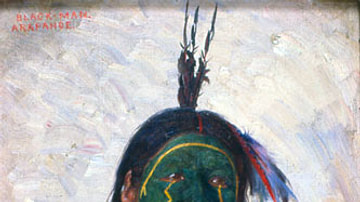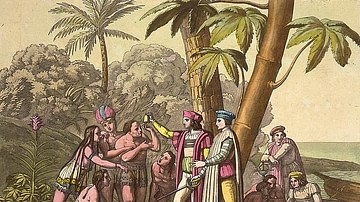Badger-Woman is a story of the Arapaho nation about a noble young hunter who refuses the advances of his sister-in-law and is then betrayed by her. The tale is similar to those of other civilizations, notably Two Brothers (The Fate of an Unfaithful Wife) from ancient Egypt, and the story of Joseph and Potiphar's Wife from the Bible.
As there is no known date of composition, it is unclear whether the Arapaho tale was inspired by the biblical story from Genesis 39 after Christianity was introduced to the Plains Indians in the 19th century. The story first appears in English in Traditions of the Arapaho (1903) by George A. Dorsey and Alfred L. Kroeber who collected tales, legends, and myths from the Southern Arapaho of Oklahoma and the Northern Arapaho of Wyoming during an expedition sponsored by the American Museum of Natural History. Dorsey and Kroeber periodically insert editorial comments throughout the work but make no attempt at dating any of the stories in the collection.
The story could easily have been composed without any knowledge of the biblical tale as similar myths and legends appear in the works of other civilizations. Aside from the Egyptian and biblical tales, Badger-Woman is also thematically similar to the myth of Bellerophon and Anteia (or Bellerophon and Stheneboea) from ancient Greece in which the princess tries, unsuccessfully, to seduce the hero and then claims he made advances on her. The Arapaho tale is also reminiscent of the story of Ning Caicheng and Nie Xiaoqian from China in which the ghost of the maiden Nie tries to seduce the hero Ning, who resists her advances. In the Chinese tale, the seductress is not punished, however, but comes to admire Ning's virtue and is eventually saved by him and restored to life.
Like these other tales, Badger-Woman was a popular tale among the Arapaho and continues to be told today in Arapaho, Cheyenne, and Sioux communities. The story fits the definition of a didactic myth – intended to teach or instruct – and a morality myth emphasizing the importance of cultural values in a given civilization.
Similarities & Symbolism
The figure of the spurned seductress first appears in world literature in The Epic of Gilgamesh when the advances of the goddess Inanna/Ishtar are rejected by the hero, and she then takes her revenge. This story is well-known, but the more obscure tale of Two Brothers (The Fate of an Unfaithful Wife) from the New Kingdom of Egypt (c. 1570 to c. 1069 BCE) is similar in theme and plot.
In this story, there are two divine brothers, Anubis and Bata, living with Anubis' wife. She tries to seduce Bata, who rejects her, claiming he cannot betray his brother, but promises he will tell no one of her solicitations. The wife, however, does not believe him and, when Anubis returns home, she tells him that Bata tried to seduce her. Anubis swears revenge on Bata, but he, warned by the gods, escapes. Anubis later learns the truth, rejects his wife – who is punished – and is reunited with Bata.
This myth is sometimes compared with the tale of Joseph and Potiphar's Wife as given in Genesis 39:6-20. Potiphar, an Egyptian official, takes the Hebrew slave Joseph into his home and makes him steward. Potiphar's wife propositions Joseph, who rejects her and runs from the house but leaves his cloak behind. The wife then claims that he attacked her, but, when she screamed, he fled, leaving his cloak in her hand. He is then arrested and thrown into prison but, guided by God, is eventually vindicated, and set free.
Badger-Woman takes its place alongside these in exploring the same theme. Two brothers are on a hunting expedition along with the wife of one of them. The wife tries to seduce her brother-in-law, is rejected, and swears revenge. The story features symbolism used in Native American literature generally and Arapaho literature specifically, including the number four, the number three, and various animals.
The number four often appears in Native American myths and legends as representing the four cardinal points of the compass and the spirits of the four winds and so is understood as sacred. The number three is sometimes used in stories to suggest balance or imbalance. The wolf is often depicted, as it is here, as a powerful spirit guide and helper, to be respected, not feared. These symbols are all used according to traditional understanding, but the badger's traditional symbolism is inverted.
The badger, traditionally, is also seen as a potent spirit guide. Scholar Bobby Lake-Thom writes:
The badger is a good sign, meaning protection, but he can also warn of danger when you are traveling…Badger medicine [spiritual power] can be warrior medicine, doctor power, and protective power. He is courageous, tenacious, and defensive.
(77)
In this story, however, Badger-Woman is duplicitous, lustful, and treacherous. Instead of defending and protecting her family, she seeks to destroy it for her own ends when she does not get her way. The wife in the story came to be associated with the animal and, for the Arapaho, changed the animal's symbolism. The story was so popular that, according to Dorsey, the Arapaho word for "badger" and for "murderer" were the same (192). Other Native peoples of North America seem to have retained the traditional symbolism of the badger, although some tales of the Cheyenne and Sioux seem to suggest they had, at least somewhat, adopted the Arapaho understanding.
Text
The following is taken from Traditions of the Arapaho (1903) by George A. Dorsey and Alfred L. Kroeber, republished by University of Nebraska Press, 1997. There are other versions of the tale, with the same plot but different details, which follow this one in Traditions of the Arapaho, pp. 192-203.
There was a man, his wife, and his brother out on a hunt, camping alone. When the husband went out hunting, his brother would go out to a hill and spend his time until toward sunset, to avoid his sister-in-law.
One day, after the husband had gone out to look for game, the wife tempted her brother-in-law to have intercourse with her, but he said to her, "Oh, sister-in-law! I cannot do that, for I love my brother and it is not right for me to do that. It does not seem right to me," said he. "If you should, neither I nor anybody else would ever tell about it," said the woman. "But, sister-in-law, I could not stand before my brother. I would be ashamed in his presence; so, it had better end here," said the young man.
The next morning, the husband went on a hunt and left his wife and his brother at home. Just as soon as he was quite a distance from the camping place, his wife went again to her brother-in-law and implored of him. "I couldn't do that under any circumstances. My brother is away, and I shall have to leave," said he. So he again went to the hill and spent a delightful day.
This young brother would be sitting on the top of the hill to look around for game or to watch for newcomers. He was singing most of the time. When he saw his brother coming home, he would start down the hill and go over to the tipi and spend a little time at home. Then his sister-in-law would attempt to persuade him. "If you will," said she, "it will be for our own love, and nobody will know about it." "No, I can't," said he, please drop it entirely." So this brother went out and stayed on the hill all day long to avoid her. Often, he was sad and cried because of his sister-in-law's behavior.
Night came on and the husband returned home. After chatting about the day's events, all retired. In the morning, the husband again started out for game. After he had gone a distance, his brother left the tipi and went toward the hill, weeping as he went.
"Now I shall fix this young man who displeases me. I am a good-looking woman and such treatment I cannot endure," said the wife to herself. So, she dug a hole underneath the bed big enough for the young man to fall into and left about four inches of ground over the hole. Her brother-in-law came to the tipi for lunch and sat down on his bed. As he did so, he fell into the deep pit and was soon covered over with earth by Badger-Woman.
Toward evening, the husband returned home and noticed his brother's absence. His wife told him that his brother had not yet returned. He was very much worried about him.
In the morning, he went to look for his brother, but could not find or see any fresh tracks leading off from the tipi. So, he returned home, very sad. "He generally comes home, when he goes to the hill, early, and at about the same time. When I was out of the tipi, I didn't see him on the hill, as I do every time," said the husband. "He must have gone home or else something has happened to him on the prairie," said Badger-Woman. The fourth time, the husband returned, looking sad, having concluded that wild beasts had destroyed his brother. So he mourned for him, together with his wife. When she cried, very bitterly, she would say under her breath, "I dropped him and buried him."
The next day, they broke camp and went back to the main camp in distress, showing appearances of mourning. They told the rest of the family that the brother had disappeared mysteriously and that they had therefore come home at once, but that there was plenty of game. The family mourned for several days, also Badger-Woman, who cried with her voice, saying, "I dropped him and buried him." Time passed on, and the sorrows gradually vanished, but still the husband would go out and weep for his brother, whom he loved very dearly.
After the brother had been covered up in the pit from seven to ten days, alive, there came a gray wolf to the deserted camping place. Seeing that the man was in great trouble, Wolf took pity on him and faced to the four directions and howled for the rest of the wolves and coyotes to come. They all came running to this place and, at once, dug the man out of the pit. He was only just alive and was very thin and exhausted from lying so long in the grave and was ready to die, when Gray-Wolf reached him. He went with the wolves, and they furnished him the meat to give him strength again.
After some time had elapsed, he obtained his usual strength again, but he did not know where his own home was. The gray wolves went away to locate it and found it along the river. So, they went with him and turned him loose in the camp, to the surprise of his own relatives. They were all glad to see him.
He told the people the reason for his absence, and of his rescue. He immediately ordered a big pemmican made, for Gray-Wolf, with the other wolves, had asked for it. They were waiting, sitting in a half-moon circle, at some distance from the camp. So the pemmican was made. The sister-in-law (Badger-Woman) then packed it and was ordered to carry it for the brother. So, they both went to feed it to the wolves and coyotes. They reached the place. "Now, Badger-Woman, carry your burden to the center where those old gray wolves are, and leave it," said the brother. She went and unloaded it from her back. Just when she dropped it on the ground, the brother said to the animals, "Here is your pemmican, together with the woman." She was eaten in no time.
The brother was saved, but she was destroyed for her wicked deed, and she was no longer a part of the people, but placed with the rest of the animals [in memory and ritual]. She (i.e., the badger skin) is called by the old men, "She-dropped-her-brother-in-law" when preparing the body of the badger for the Sundance lodge.






